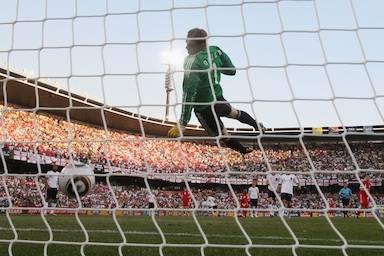Unanimous decisions were also cast in favour of the five-officials system - which came under particular but not fatal scrutiny at Euro 2012, - and the new ‘safety headscarf’ for Muslim women players.
However goal-line technology was the major issue. This was arguably the most significant decision taken since the change in the offside law in the early 1920s.
In the short term, it will offer more public relations credibility to the game’s decision-making process than practical effect. Goal-line dispute are few and far between and very few leagues, initially, will be able to afford the $250,000-per-club installations.
The two systems currently blinking in the glare of IFAB approval are camera-based Hawkeye – a name already familiar in the world’s of top-level tennis and cricket – and a sensor-based German/Danish collaboration called GoalRef.
FIFA’s own Club World Cup, in
The most notorious was-it-or-wasn’t-it goal was scored by Geoff Hurst in the 1966 World Cup Final at Wembley. The score was 2-2 between
Ironically the impetus to bring GLT back to the IFAB agenda was a similar incident in the second round of the 2010 World Cup in South Africa when England were on the wrong end of a decision in a 4-1 defeat by Germany.
The weight of worldwide ridicule persuaded FIFA president Sepp Blatter to end his long opposition to technology and push the lawmakers down the road which has ended in Thursday’s decision – described as “momentous” by Patrick Nelson, from the Irish Football Association.
Any league or federation which wishes to use a GLT system should go direct to the companies to negotiate installation time and price, maintenance costs etc. Each individual stadium installation would need to undergo a FIFA quality test before being approved for ‘match action.’
England’s FA has made no secret, for many years – before the Lampard incident in 2010 – of its impatience for the arrival of GLT.
Hence FA chief executive Alex Horne thought this “a hugely important day.” He added: “It’s a cause we’ve had on our agenda for a number of years . . . it’s a great step for football.” But he cautioned: “It’s not appropriate for technology to creep out into anywhere else on field of play which would undermine the job of the referee. Goal-line technology is where it stops.”
Source: AIPS Website
Somali Football Media Department
Email:somalifootballmedia@gmail.com

